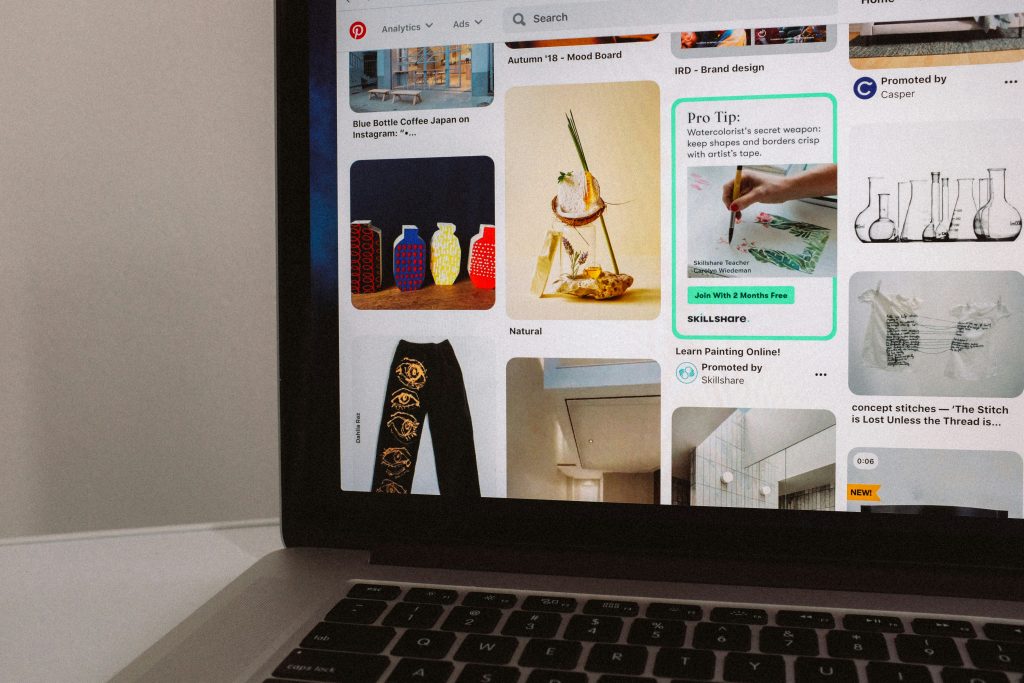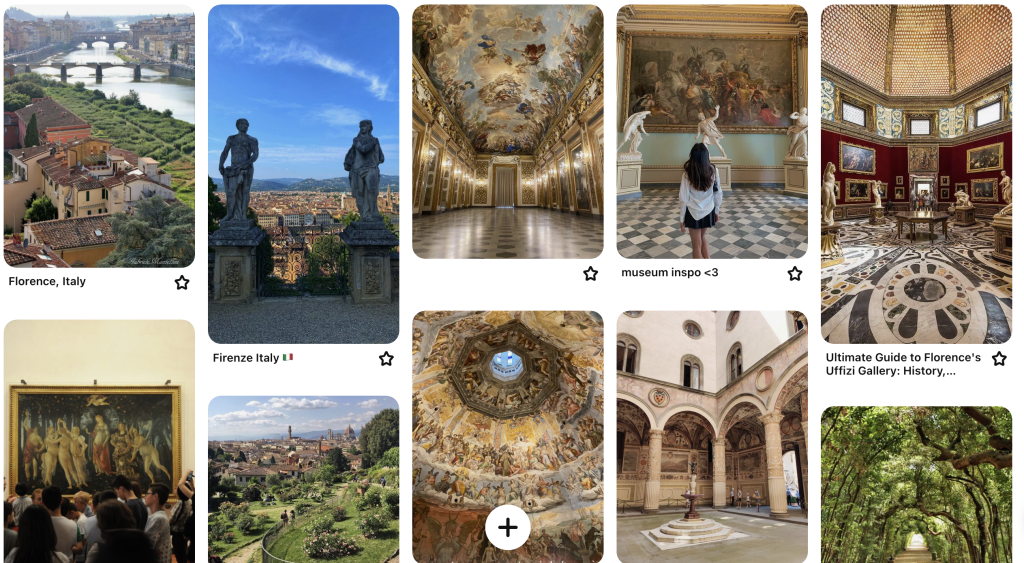For one of the last blogs, I decided to discuss the phenomenon of Pinterest—the heaven of aesthetics. This social media platform was created by Ben Silbermann in 2010, initially inspired by his childhood hobby of collecting things like insects and stamps. The key word here is collecting, since the essence of Pinterest is to browse through images and collect and curate them in boards. It works like a virtual inspiration board or scrapbook.

Pinterest, as I mentioned before, is a social media platform that is often perceived as the most positive and user-friendly. I believe this is partially true because Pinterest isn’t very social. The platform doesn’t prioritize user interactions; instead, it focuses on providing a more individual experience. Consequently, it is a safe space without toxic behavior—just cute and positive pictures.
There are many ways users engage with Pinterest content. The most popular searches are wedding inspirations, recipes, home decor and interior design, fashion, DIY, travel inspirations, health, and beauty, etc. Some people save images they need or like and organize them into boards, categorizing the content by specific topics. This type of collecting allows them to come back and look back at ideas they saved, for example, for dinner or party decorations.
However, the type of users who interest me the most are people who create mood boards, which are just manifestations or visualizations of life. Frequently, these boards are organized by specific time periods. For instance, they might be named Fall 2024, My Summer Adventures, Springtime Bliss, or Christmas Vibes. These boards serve as creative expression rather than practical tools for materializing ideas in real life. Users mainly create these boards to imagine what their lives could look like, but the paradox is that these images often don’t represent real goals; they are just pictures meant to be collected and displayed. So my question is, what’s behind this? Are people just obsessed with looking at beautiful pictures and seeking quick bursts of dopamine while imagining that these are reflections of their own lives?

Pinterest is becoming increasingly commercialized (as every other platform, I believe). Behind those perfect images are tons of ads, links, and marketing messages, which apparently are very efficient. Research indicates that Pinterest users are more inclined to make purchases compared to users of other social media platforms. Specifically, 89% of Pinterest users report using the platform for purchase inspiration, and 47% have bought something after seeing a promoted pin. This makes Pinterest a powerful platform for e-commerce and marketing. Essentially, if you want your summer to look like the board My Summer Adventures, all you need to do is buy that dress from the picture you saved. Nonetheless, the question remains: does Pinterest promote consumerism, or does it serve as a convenient platform for discovering potential purchases?
Overall, it is a funny platform, revealing the simplicity of people’s needs. Individuals just like to admire beautiful, curated, and positive images that they try to recreate in their lives and imagine their lives as a curated mood board. Thus, aesthetics and beauty are one of our essential needs.
More information: Kasakowskij, Regina & Kasakowskij, Thomas & Fietkiewicz, Kaja. (2020). Pinterest: A Unicorn Among Social Media? An Investigation of the Platform’s Quality and Specifications. 10.34190/ESM.20.042.


Interesting pov on Pinterest! I had a similar reflection about it the other day when I was scrolling and suddenly realized that at least 1 out of 3 pins that were shown to me were ads and not organic pins that were there for mere inspiration purposes, which made feel rather frustrated. I feel like this has definitely been a more and more frequent feeling these days using social media, unfortunately. Side note: I really like the Florence trip moodboard you and your friend made 🙂 I was also there this summer and it’s beautiful!
I do agree that Pinterest is way more commercialized than a few years ago.. I still love it and frequently use it for my own vision boards 🙂 I also heard that Pinterest is very easy to make money from as a creator because of these ads without showing your face etc.
The commercialization of Pinterest frustrates me so much! It used to be the last platform where I didn’t feel like companies were trying to push their products at me, at least not too obviously.
The quality of the search engine seems to have been declining too. It used to be quite accurate and precise, whereas nowadays, whenever I search for anything related to fashion I just get inaccurate ads instead of what I was initially trying to find. My hack is to add the word “aesthetic” to every search I do on the platform, it seems to filter out the ads (at least partially).
ps. love that you mentioned our Italian Summer 2024 board <3 haha
I think creating mood boards visualizing certain aspects of life can serve people in several ways. I created vision boards with my friends right at the beginning of the year to highlight the resolutions and plans we made for 2024, and I think gathering all of these ideas in one place made it very convenient to look back at after a while to see what worked and what didn’t It is a good form of motivation and every time I revisit the board it is satisfying to realize that some of my manifestations became a reality! Mood boards can also be used as a repertory of inspiration for activities you can do with your friends or when you travel to a new place. Sometimes your mind goes blank
when you’re trying to come up with ideas for where to go and then looking at a board might save you.
When it comes to the commercialization of Pinterest, I also noticed the increasing number of ads there, and I find it rather annoying. However, there’s another thing that I see as problematic. I often use the platform to search for artistic inspiration, and while it works very well and surely introduced me to many incredible new artists. I noticed that it is quite common for people to post someone’s art without giving them any credit, which I find extremely disrespectful. As some Pins become very popular and are reposted multiple times, it could be a chance for smaller artists to gain new audiences. Instead, their art floats on the internet with no indication of who it belongs to.